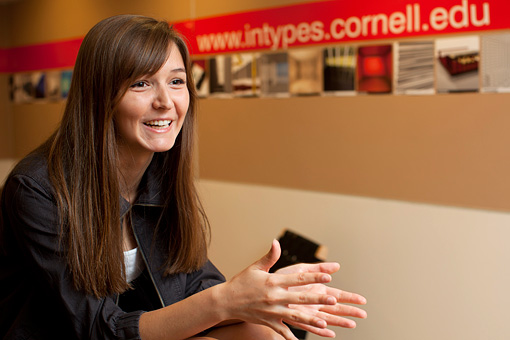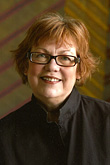
Emily Mitchell, a junior majoring in interior design in the College of Human Ecology, is one of Cornell's newest Rawlings presidential scholars. She is working on the Intypes project with design and environmental analysis professor Jan Jennings.
Newest Rawlings scholar captivated by 'red room' and shared language of interior design

Mitchell is conducting research on "red room" -- the archetypal name for a room in which all walls are rendered in a monochromatic red. Above is an example of red room: the Infiniti Room VIP Lounge in Le Méridien Chambers Minneapolis. Red room is used in the hospitality industry, restaurants and home interiors. This image is part of the Intypes online database. Photo by David Joseph Photography.
Emily Mitchell '13 saw her first "red room" during a class project last year while studying the interior design of a house in London.
She soon learned that "red room" -- the archetypal name for a room in which all walls are rendered in a monochromatic red -- had been so named by the Interior Archetypes Research and Teaching Project, or Intypes Project. This is a Cornell research group that her teacher, design and environmental analysis professor Jan Jennings, launched in 1997.
Mitchell, an interior design major in the College of Human Ecology, is working on continuing to categorize and refine the "red room" intype as an ongoing research project. She was recently chosen as one of Cornell's newest Rawlings presidential scholars, which will give her additional funding and support for her research for the next two years.
The Intypes Project
The Intypes Project has been creating a common language for interior designers and architects since 1997, identifying design practices that have been used throughout history and across cultures but that were not formally named or documented. For example, there was no term for a dramatic staircase in the lobby of a luxury hotel (now named "showcase stair") or for two similar chairs set side by side in a large space (now termed "lonely couple"). Other intypes include "ghost hearth," "1 bar 2," "padded perimeter," "marching order," "scene seen" and more.

Jan Jennings
The project, which has so far named 71 interior archetypes with more to come, includes a searchable website for contemporary design with ample imagery. Research for the project is supervised by an interdisciplinary group of four graduate faculty representing three Cornell colleges.
Alumni have been reporting that the terms created by the project are being used by professionals in the field without an accompanying translation or definition -- something Jennings sees as evidence of the project's growing success.
Now that researchers have a shared and codified vocabulary for specific interior design practices, Jennings says, they can study issues related to them individually, such as their sustainability, and it also opens the door to more formal research in interior design.
The project really made inroads into the architecture and design world once the extensive website, built by Cornell Information Technologies, went live a few years ago, Jennings says. Jennings and interior design professor Kathleen Gibson funded the creation of the website through support from the college and a Cornell Faculty Innovation in Teaching award.
"We have a visual database that nobody else has," Jennings says. "Our site is the only one on the Web that can offer such published work with imagery by architects and designers."
Research into the 'red room'
The Intypes Project grabbed Mitchell's interest this spring. "Professor Jennings, throughout studio and other classes, always had us identify intypes wherever we were," Mitchell says, "and I started seeing them in stores and back home." In fact, she realized that her house in Connecticut had a red room.
Red room is one of the oldest European (and possibly Asian) archetypes. According to the Intypes website, a room with all-red walls is often used to create contrast and autonomy between that room and another. Red rooms are found in restaurant, museum, resort, spa and other settings. This summer, Mitchell is researching the use of red room in house design.
Jennings points out that while many undergraduates do research with faculty in their department, "This really is [Mitchell's] own project. … These are usually graduate students who do these studies; she will be the first undergraduate to really tackle an intype by herself. And it's a big broad intype with lots of deep history and may have more than one cultural source."
During her two years of research as a Rawlings scholar, Mitchell will likely be able to work on additional intypes. She says she would like to study intypes specific to the health care industry -- a new category for the project -- since her goal is to eventually design hospitals, which is a rapidly developing field in in interior design.
"There's just so much that can be changed," she says. "It's much better for patients to feel that they're not in a hospital, because no one wants to be in the hospital. I want to help patients through my design."
Rawlings scholars
As a Rawlings scholar, Mitchell will be working under Jennings in her junior year and then under landscape architecture professor Paula Horrigan in her senior year, since Jennings will be retiring.
The research scholars program was created with an anonymous gift to the university in 1996 and was named for former President Hunter R. Rawlings III in 2006. The program supports a select group of undergraduate students from all colleges and many disciplines by providing research support and promoting sustained engagement in research with faculty and other mentors. Up to 200 students are supported each year.
The program provides each scholar with a research support account ($8,000 for scholars admitted as freshmen; $5,000 for those admitted as juniors) and an annual need-based loan replacement of up to $4,000.
The program is part of The Cornell Commitment, which also includes the Meinig Family Cornell National Scholars program and The Cornell Tradition.
Related links:
Interior Archetypes Research and Teaching Project at Cornell
Cornell Chronicle: Seniors present research across disciplines at annual expo